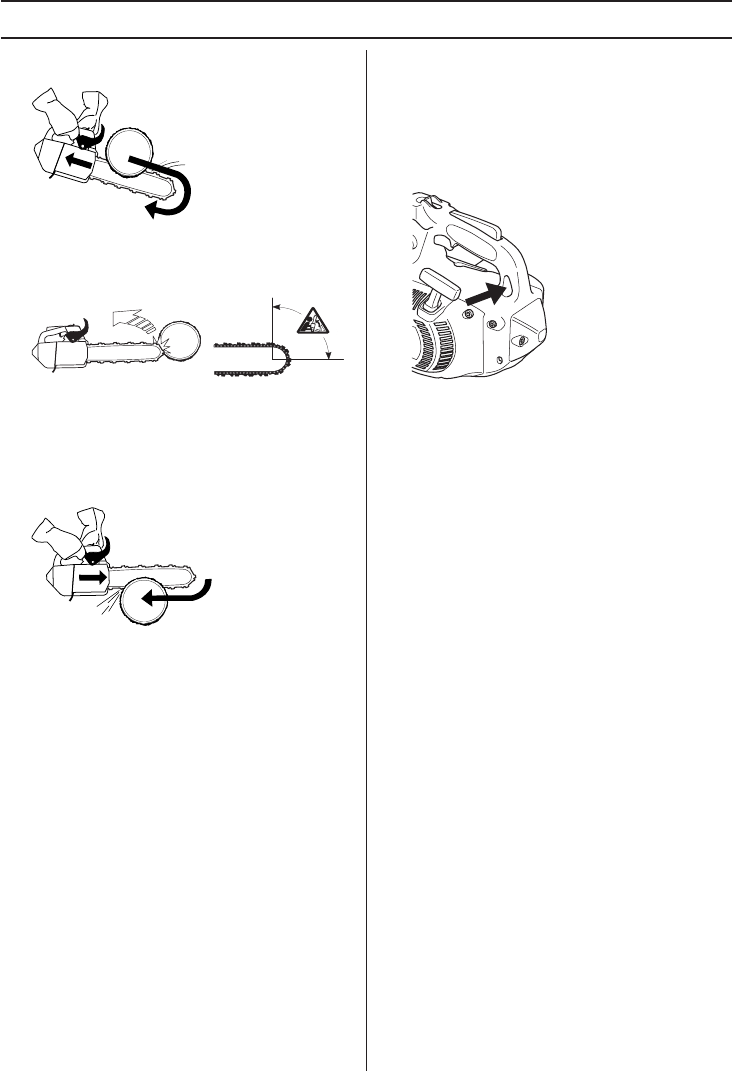
WORKING TECHNIQUES
English – 23
user. If the saw chain is jamming, the saw may be
pushed back at you.
8 Unless the user resists this pushing force there is a
risk that the chain saw will move so far backwards that
only the kickback zone of the bar is in contact with the
tree, which can lead to a kickback.
Cutting with the bottom edge of the bar, i.e. from the top
of the object downwards, is known as cutting with a
pulling chain. In this case the chain saw pulls itself
towards the tree and the front edge of the chain saw
body rests naturally on the trunk when cutting. Cutting
with a pulling chain gives the operator better control over
the chain saw and the position of the kickback zone.
9 Follow the instructions on sharpening and maintaining
your bar and chain. When you replace the bar and
chain use only combinations that are recommended
by us. See instructions under the headings Cutting
equipment and Technical data.
Working with tree service chain-saws
from a rope and harness
This chapter sets out working practices to reduce the risk
of injury from tree service chainsaws when working at
height from a rope and harness. While it may form the
basis of guidance and training literature, it should not be
regarded as a substitute for formal training.
General requirements working at height
Operators of tree service chainsaws working at height
from a rope and harness should never work alone. A
competent ground worker trained in appropriate
emergency procedures should assist them.
Operators of tree service chainsaws for this work should
be trained in general safe climbing and work positioning
techniques and shall properly equipped with harnesses,
ropes, strops, karabiners and other equipment for
maintaining secure and safe working positions for both
themselves and the saw.
Preparing to use the saw in the tree
The chain saw should be checked, fuelled, started and
warmed up by the ground worker and the chain brake
should be engaged before it is sent up to the operator in
the tree. The chainsaw should be fitted with a suitable
strop for attaching to the operator’s harness:
a) choke the strop around the attachment point on the rear
of the saw.
b) provide suitable karabiners to allow indirect (i.e. via the
strop) and direct attachment (i.e. at the attachment point
on the saw) of saw to the operators harness.
c) ensure the saw is securely attached when it is being
sent up to the operator.
The saw should only be attached to the recommended
attachment points on the harness. These may be at mid-
point (front or rear) or at the sides. Where possible
attaching the saw to centre rear mid-point will keep it clear
of climbing lines and support its weight centrally down the
operator’s spine.
When moving the saw from any attachment point to another,
operators should ensure it is secured in the new position
before releasing it from the previous attachment point.
Using the chainsaw in the tree
An analysis of accidents with these saws during tree
service operations shows the primary cause as being
inappropriate one-handed use of the saw. In the vast
majority of accidents, operators fail to adopt a secure
work position witch allows them to hold both handles of
the saw. This results in an increased risk of injury due to:
• not having a firm grip on the saw if it kicks back.
• a lack of control of the saw such that it is more liable
to contact climbing lines and operators body
(particularly the left hand and arm)
• loosing control from insecure work position resulting
in contact with the saw (unexpected movement during
operation of the saw)
Securing the work position for two-handed use
To allow the operator to hold the saw with both hands,
they should as general rule, aim for secure work position
where they are operating the saw at:
• hip level when cutting horizontal sections.
• solar plexus level when cutting vertical sections.
Where the operator is working close into vertical stems
with a low lateral forces on their work position, then a good
footing may be all that is needed to maintain a secure
work position. However as operators move away from the


















